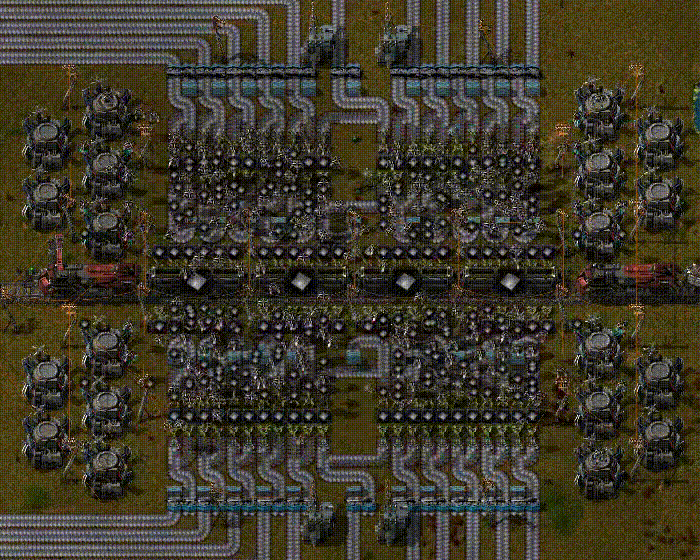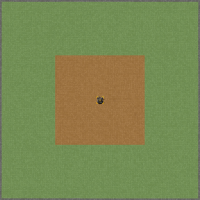User talk:JakubSTR
Welcome to the Official Factorio Wiki! Now that you have an account, there are a few key places on this Wiki that will be helpful in your efforts to improve it.
First and foremost, please be sure to read and understand the rules of this Wiki. If you have any questions or concerns with these rules, please don't hesitate to ask an Admin.
Secondly, if you're new to editing Wikis and are unfamiliar with MediaWiki's formatting, please be sure to read the help pages. In addition to the help provided by MW, we also provide a style guide that we enforce.
If you're unsure where to begin, please see the editor noticeboard, where information on the current objectives and projects of the Wiki may be found.
Again, welcome, we hope you contribute as much high quality information as you can. :) Bilka (talk) - Admin 10:58, 6 February 2018 (UTC)
Sieć logistyczna

Logistic network to zestawienie różnych skrzyń logistycznych będących w zasięgu jednego lub więcej Roboportów, które są obsługiwane przez roboty logistyczne.
W zależności od rodzaju i konfiguracji skrzyń oraz obszaru sieci robotów, roboty będą transportować przedmioty pomiędzy skrzyniami. Jest to mocno wymagająca energii alternatywa przenoszenia przedmiotów. Jednakże roboty mogą przenosić przedmioty w linii prostej - nie zważając na przeszkody.
Gracz również może pełnić funkcję skrzyni żądającej w sieci logistycznej. Dzięki temu gracz może sobie zapewnić konkretną ilość przedmiotów w ekwipunku. Aby móc 'zamawiać' przedmioty z systemu logistycznego należy zbadać Character logistic slots (research) oraz być w zasięgu sieci logistycznej.
Nie można mylić sieci logistycznej z siecią sterowniczą. Mają wspólne komponenty, ale są rozdzielone ze sobą i nie wymieniają ze sobą informacji. Nie należy również mylić sieci logistycznej z siecią konstrukcyjną (nazywane łącznie: Robotic network)
Osiągnięcia

|
You've got a package Supply the character by logistic robot. |

|
Delivery service Supply the character with 10k items delivered by logistic robots. |

|
Logistic network embargo Finish research with space science pack for the base game or any planetary science pack for Space Age |
Składniki sieci logistycznej
| Składnik | Opis |
|---|---|
| roboport | Centralny punkt sieci robotów, przechowywane są tam niepotrzebne aktualnie Roboty, są w nim również ładowane. Roboport określa zasięg sieci logistycznej oraz sieci konstrukcyjnej. |
| Logistic robot | Przenosi przedmioty pomiędzy skrzyniami logistycznymi.1 |
| Active provider chest | Skrzynia logistyczna: 'Wypycha' przedmioty do innych skrzyń w sieci logistycznej.2 |
| Passive provider chest | Skrzynia logistyczna: Umieszczone w niej przedmioty są do dyspozycji w sieci logistycznej.2 |
| Storage chest | Skrzynia logistyczna: Przechowuje aktualnie niepotrzebne przedmioty. Są dostępne dla innych skrzyń w sieci.2 |
| Requester chest | Skrzynia logistyczna: Dąży do posiadania określonej liczby przedmiotów, które dostarczane są przez roboty logistyczne. Przedmioty są dostarczane do momentu osiągnięcia określonej ich liczby w skrzyni. Skrzynia żądająca może żądać różnych przedmiotów jednocześnie.2 |
| Buffer chest | Skrzynia logistyczna: Skrzynia łącząca funkcjonalności requester chest oraz passive provider chest.2 |
(1) Początkowa pojemność robotów to 1 przedmiot. Ta liczba może być zwiększona, badając Worker robot cargo size (research).
(2) Skrzynie logistyczne mogą być podłączone do Circuit network za pomocą Red wire lub Green wire.
Korzystanie z sieci
Aby rozpocząć korzystanie z sieci logistycznej wystarczy użyć pasywnej i żądającej skrzyni logistycznej. Umieść skrzynię pasywną na wyjściu Template:Inserters pobierającego przedmioty z Assembling machine oraz skrzynię żądającą na wejściu podajnika podającego przedmioty do automatu montażowego. Ustaw skrzynię żądającą, aby żądała przedmiotów będących składnikami ustawionej w automacie montażowym receptury. Umieść Roboport, musi obejmować te skrzynie pomarańczowym obszarem. Umieść trochę robotów logistycznych w roboporcie. Pamiętaj, aby robot mógł wziąć jakiś przedmiot - musi on się znajdować w skrzyni logistycznej będącej w zasięgu danej sieci logistycznej.
Sieć logistyczna jest wygodna w wytwarzaniu złożonych przedmiotów na niewielkim obszarze. W przypadku małej złożoności produkcji jak również produkcji na długich dystansach (np. wytapianie) należy obsługiwać za pomocą taśmociągów lub sieci kolejowej.
Sieć logistyczna jest bardzo zdolna do tworzenia coraz bardziej złożonych elementów w stosunkowo niewielkim obszarze fabrycznym. Niska złożoność i duża aktywność na dłuższych dystansach (np. Wytapianie) można (i należy) pozostawić za pomocą pasów lub sieci kolejowej.
Logistic network is very capable for creating more and more complex items in a relatively small factory-area. Low complexity and high volume activities over longer distances (like smelting) can (and should) be left using belts or railway network.

The basic thing needed for item transportation are Roboports. When placing the port and hover over it, notice an orange and a larger green area.
- The orange zone is the Logistic Network area. This is also the maximum distance for connecting two roboports.
- The green zone is the Construction area.
For more info on the specifics of how roboports work, check the page dedicated to them.
Expand the logistic zone
There can be many separate logistic networks. Two roboports are in the same network only if they are connected, as described above. Visually this is represented by a dashed yellow line connecting them. To prevent roboports from linking, the Player needs to build them far enough away from each other so that the orange zones don't touch.
Bots do not fly from one network into another, unless requiring a recharge. Robots will never "nest" in a different network.
Losing bots
Logistics robots are a priority target of biters, and will prioritize attacking them over many objects in the vicinity of the robots. Destroyed robots will not be replaced, unless automatic control of the robot creation system is used.
Bots are not destroyed when running out of energy, but will be reduced to 20% of their speed, which gives them the chance to recharge eventually and a chance for the player to notice the problem.
Pay attention to robotic networks which form some kind of U-shape (where the shortest way between two chests goes over an uncovered area): if a bot runs out of charge in this area, and cannot return fast enough to a roboport, the bot will be significantly slowed and as a result the logistics network will frequently slow down, with large groups of bots slowly flying over the uncovered area.
Robots may run out of charge on longer journeys. When the charging-queue for the bots gets too long, the bots (and their loads) will slow down. Generally, a roboport can charge between 50 and 70 bots per min, 4 at a time, but are not very efficient at charging large queues of bots and can quickly become overworked. Place more roboports near the first one to share the load.
Negative numbers
It is possible to notice negative numbers on the 'Logistic Network'-Screen when looking at network storage. Contrary to common belief, this is intended.
The logistic network numbers report items in provider and storage chests, minus the amount of items scheduled to be picked up by robots. When negative numbers are shown, it means that more items are being requested than are available in the network. There is a deficit. This can be a problem, or intended, depending on the player's choice. The negative value is just to explain why items aren't being delivered. For example, a deficit of 20 iron plates would look like this:
Receiving more items than requested
The delivered number of items in the requester chest can be higher than requested. This depends on the researched Worker robot cargo size-bonus, since bots will always take as much as they can carry if an unlimited amount is available.
Priorities of robots
This overview reflects the priorities in which order the chests are filled/emptied.
Logistic robots on the logistic network looks for orders by the chests in this order:
- A requested item is first looked up in the active provider chests, then in the storage chests, then the passive provider chests. So, the active provider chests are emptied first, then the storage chests, then the passive provider chests.
- If robots are free and there is space left in storage chests, and there are unrequested items in an active provider chests, the items are moved from active provider to a storage chest.
- For the storage chests, the bots search for one storage which has the same item already. If that can't be found, they choose the first storage chest with a free slot from the list, which is sorted by the order they were built in. [1] This is to avoid having storage chests with different items inside, allowing greater organisation.
Storage chests will be filled with items from active provider chests, and from construction robots that have had their orders cancelled while they were carrying items.
Order of movement
The bots fulfill all requests with the same priority. The algorithm looks for the next free robot, then the next request in the queue and after giving orders to the robot, this request is put at the end of the queue, so that first all other requests are done.
Distance
When looking to pick up requested items from multiple chests of equal priority, bots will always choose the closest one. [2] This is however only true when an item is being requested, not when an item is sent away. [3] In the case of items being sent into the logistics network distance does not matter, and the rules laid out above matter instead.